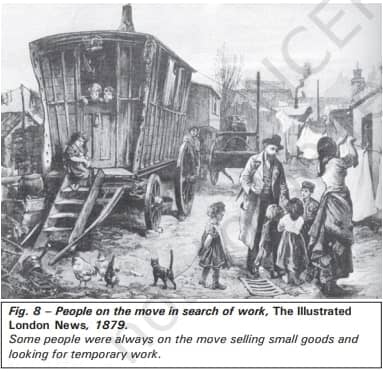NCERT History Class 10 | Hand Labour and Steam Power – Concept and Notes
Topic & sub-topics covered: Hand Labour and Steam Power, Life of the Workers: The Age of Industrialisation (All single detail notes are exam-oriented).
We have discussed in-depth and exam-oriented pointers that can be asked in the board exam of class 10th about “MarketHand Labour and Steam Power, Life of the Workers” which is taken from the NCERT History book for class 10th chapter no. 4 “The Age of Industrialisation“.
Download NCERT History Chapter 4 Class 10th Notes PDF for The Age of Industrialisation
If you are in class 10th and looking for free NCERT History chapter 4 notes of the chapter The Age of Industrialisation class 10 that cover concepts, then you can download the free class 10th History chapter 4 notes “The Age of Industrialisation”. You should download this free PDF for future test or exam preparations.
Hand Labour and Steam Power

1. Abundance of Human Labor:
- In Victorian Britain, there was an ample supply of human labour.
- Peasants and vagrants migrated to cities in large numbers in search of jobs.
2. Low Wages and Industrialists’ Perspective:
- Abundance of labour led to low wages in Victorian Britain.
- Industrialists preferred low-wage human labour over introducing machines requiring high capital investment.
3. Seasonal Demand for Labor:
- Many industries experienced seasonal demand for labour in Victorian Britain.
- Gasworks, breweries, bookbinders, printers, and waterfront industries hired more workers during peak demand periods.
4. Preference for Hand Labor:
- Industries with fluctuating seasonal demand preferred hand labour over machines.
- Hand labour was essential for products with intricate designs and specific shapes.
5. Diversity in Product Types:
- Hand labour was crucial for producing diverse products with specific designs.
- For example, in mid-19th-century Britain, 500 varieties of hammers and 45 kinds of axes were produced, requiring human skill.
6. Symbolism of Handmade Products:
- In Victorian Britain, handmade products symbolized refinement and class.
- Upper classes, including aristocrats and the bourgeoisie, preferred goods produced by hand.
7. Handmade vs. Machinemade Goods:
- Handmade products were considered better finished, individually produced, and carefully designed.
- Machine-made goods were often produced for export to the colonies.
8. British Industrialists and Human Labor:
- Unlike countries with labour shortages, British industrialists were not keen on using mechanical power to minimize human labour.
- Britain had no difficulty in hiring human hands due to the abundance of labour.
Understanding the dynamics of the labour market, seasonal demand, the preference for hand labour, and the symbolic significance attached to handmade products provide insights into Victorian Britain’s industrial landscape.
Life of the Workers

1. Impact of Abundant Labor:
- Abundance of labour influenced workers’ lives during the Industrial Revolution.
- Hundreds migrated to cities in search of jobs, affecting job availability.
2. Social Networks and Job Opportunities:
- Job prospects were influenced by existing networks of friendship and kin relations.
- Having relatives or friends in factories increased the likelihood of securing employment.
3. Challenges Faced by Jobseekers:
- Many job seekers faced challenges, waiting for weeks and spending nights under bridges or in shelters.
- Night Refuges and Casual Wards provided temporary accommodations for those seeking work.
4. Seasonality of Work and Unemployment:
- Seasonal work in industries led to prolonged periods without employment.
- Economic slumps, like in the 1830s, resulted in unemployment rates ranging from 35 to 75 per cent in different regions.
5. Wage Fluctuations and Economic Conditions:
- Wages increased somewhat in the early 19th century, but the real value fell during periods of rising prices.
- Income depended not only on the wage rate but also on the period of employment.
6. Fear of Unemployment and Workers’ Hostility:
- Fear of unemployment made workers resistant to the introduction of new technology.
- The introduction of the Spinning Jenny in the woollen industry led to conflicts, with workers attacking the new machines.
7. Building Boom and Employment Opportunities:
- After the 1840s, increased building activity in cities provided more job opportunities.
- Expansion of infrastructure projects, such as roads, railway stations, and drainage, created employment prospects.
8. Growth in Transport Industry Employment:
- Employment in the transport industry doubled in the 1840s and continued to grow in the subsequent 30 years.
- Building projects and railway expansion contributed to the increased demand for labour.
Understanding the challenges faced by workers, the impact of social networks on job opportunities, and the dynamics of wage fluctuations provides insights into the socio-economic conditions during the Industrial Revolution.
Next & Previous Topics of NCERT/CBSE History Class 10 Chapter 4: The Age of Industrialisation
FAQ
Q1. How did hand labour and steam power impact the industrial revolution?
Answer: Hand labour and steam power played a significant role in the Industrial Revolution, which transformed economies from agrarian and handicraft to industrial and machine manufacturing-dominated. The use of steam power in factories and transportation systems, such as steam locomotives, steamboats, and steamships, revolutionized production processes and increased efficiency.
The development of the steam engine, which began with Thomas Newcomen’s atmospheric engine in 1712 and was later improved by James Watt, was one of the most important technologies of the Industrial Revolution. The rise of factories and the concentration of labour led to the mechanization of production processes, making industries more productive and efficient. The Industrial Revolution brought about significant changes in economic and social organization, leading to the rise of new industries and the transformation of existing ones.
Q2. What were the advantages of using steam power over hand labour during the Industrial Revolution?
Answer: The advantages of using steam power over hand labour during the Industrial Revolution were significant. Steam power provided many benefits that couldn’t be realized by relying solely on hand labour, allowing it to quickly become the dominant power source in industrialized nations. Some of the key advantages included:
- Increased Power Generation: Steam engines allowed for a substantial increase in power generated, making industrial processes more efficient and productive.
- Agglomeration Potential: Steam power facilitated the agglomeration of production, making it possible to work, produce, and market goods more viably, and to expand westward without being limited by the presence of waterways.
- Reduced Production Costs: Steam power may have reduced production costs, leading to higher profits and the ability to mass-produce consumer goods at a lower cost.
- Mutual Stimulation of Industries: The coal, iron, and steel industries mutually stimulated each other during the Industrial Revolution, creating a self-perpetuating global phenomenon driven by steam power.
- Cheaper and Easier Production: Steam power became the energy source for many machines and vehicles, making it cheaper and easier to produce commodities in large amounts.
In summary, the advantages of steam power over hand labour were instrumental in driving the Industrial Revolution, leading to increased efficiency, reduced costs, and the widespread adoption of steam engines across various industries.

